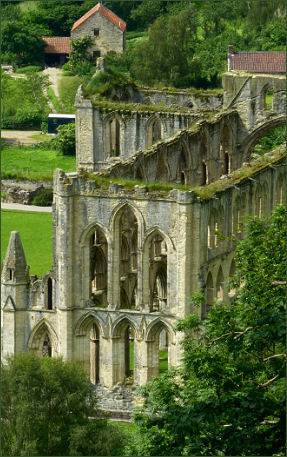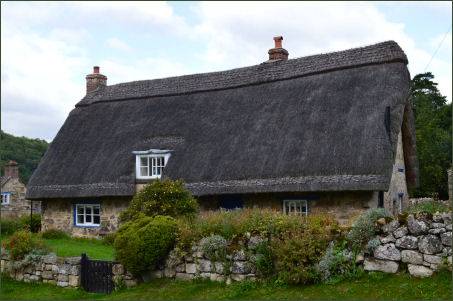Rievaulx
OS grid reference:- SE 573 848
 The picturesque village of Rievaulx is situated in stunning moorland scenery near Helmsley, Ryedale in the North York Moors National Park.
The picturesque village of Rievaulx is situated in stunning moorland scenery near Helmsley, Ryedale in the North York Moors National Park.
 The village is located in what was once the inner court of the mighty Rievaulx Abbey, owned by the Cistercian order and lies close to the River Rye. The name Rievaulx derives from the Norman French language, a corruption of Rye Vallis, or Rye Valley
The village is located in what was once the inner court of the mighty Rievaulx Abbey, owned by the Cistercian order and lies close to the River Rye. The name Rievaulx derives from the Norman French language, a corruption of Rye Vallis, or Rye Valley
The inner court of the abbey contained a variety of buildings such as the brewhouse, bakehouse and guesthouse. Its name originated as Rye (the river) and the Norman-French word val or valle meanng "valley". Its old local pronunciation was as "Rivers", and changed to "Reevo" when education brought a general familiarity with the French language.
Rievaulx Abbey was founded in 1131 by Cistercian Monks who came from Clairvaux, in France, at the instigation of St Bernard of Clairvaux (1090 - 20 August 1153), a French abbot and the primary reformer for the Cistercian order. The abbey was established on land given by Walter Espec, lord of nearby Helmsley and a royal justiciar, who was an active supporter of ecclesiastical reform. It was once one of the richest abbeys in England, the ruins are now owned by English Heritage.
The abbey was closed as part of the Dissolution of the Monasteries under King Henry VIII on 3rd December, 1538 and the grounds were purchased by the Thomas Manners, Earl of Rutland, one of the king's advisors.
The Earl of Rutland was keen to profit by the continuation of the iron-smelting industry which had been conducted by the monks of the abbey. He therefore established a charcoal-fired blast furnace and the associated structures and workings in what was to become Rievaulx village. Manners employed the former iron master of the abbey and built up a profitable business, using the undercroft to store the charcoal used in heating the iron ore.
This continued until its disruption during the Civil War, with production ceasing in 1647. The village then became agricultural in nature and remains as a small settlement, situated below the Abbey and the Rievaulx Terrace & Temples.
The village has a wealth of picturesque old stone cottages. The old watermill has been converted into a house around the workings, many of which are still extant, including the mill wheel, though the mill has been out of operation for a long time. The miller's cottage also still stands and is a separate dwelling.
The village church of St.Mary, a Grade II listed building, which stands on the main street, was once the abbey's gatehouse chapel. The only outer building of the abbey to have substantially survived, it has now been restored and boasts work from the thirteenth century.


Perhaps the best view of the great ruins of the abbey is across the landscape from Rievaulx Terrace, built in the mid-eighteenth century by Thomas Duncombe of Duncombe Park. The National Trust now own the terrace, it has sweeping lawns and two Neoclassical temple style 'folly' buildings and is open to the public.


When he was raised to the House of Lords in 1983, former Labour prime minister Harold Wilson took the title Baron Wilson of Rievaulx.
